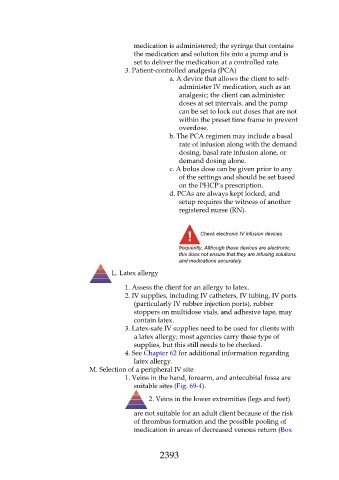Page 2393 - Saunders Comprehensive Review For NCLEX-RN
P. 2393
medication is administered; the syringe that contains
the medication and solution fits into a pump and is
set to deliver the medication at a controlled rate.
3. Patient-controlled analgesia (PCA)
a. A device that allows the client to self-
administer IV medication, such as an
analgesic; the client can administer
doses at set intervals, and the pump
can be set to lock out doses that are not
within the preset time frame to prevent
overdose.
b. The PCA regimen may include a basal
rate of infusion along with the demand
dosing, basal rate infusion alone, or
demand dosing alone.
c. A bolus dose can be given prior to any
of the settings and should be set based
on the PHCP’s prescription.
d. PCAs are always kept locked, and
setup requires the witness of another
registered nurse (RN).
Check electronic IV infusion devices
frequently. Although these devices are electronic,
this does not ensure that they are infusing solutions
and medications accurately.
L. Latex allergy
1. Assess the client for an allergy to latex.
2. IV supplies, including IV catheters, IV tubing, IV ports
(particularly IV rubber injection ports), rubber
stoppers on multidose vials, and adhesive tape, may
contain latex.
3. Latex-safe IV supplies need to be used for clients with
a latex allergy; most agencies carry these type of
supplies, but this still needs to be checked.
4. See Chapter 62 for additional information regarding
latex allergy.
M. Selection of a peripheral IV site
1. Veins in the hand, forearm, and antecubital fossa are
suitable sites (Fig. 69-4).
2. Veins in the lower extremities (legs and feet)
are not suitable for an adult client because of the risk
of thrombus formation and the possible pooling of
medication in areas of decreased venous return (Box
2393

